 Time once again to tackle the Session, a.k.a. Beer Blogging Friday: a monthly opportunity for beer bloggers from around the world to get together and write from their unique perspective on the same topic. Each month, a different beer blogger hosts The Session, chooses a topic, and creates a round-up that lists all of the participants.
Time once again to tackle the Session, a.k.a. Beer Blogging Friday: a monthly opportunity for beer bloggers from around the world to get together and write from their unique perspective on the same topic. Each month, a different beer blogger hosts The Session, chooses a topic, and creates a round-up that lists all of the participants.
This month’s session is hosted by Reuben Gray at the Tale of the Ale. He wants to know about your local brewing history:
In Session 87, I want you to give your readers a history lesson about a local brewery. That’s a physical brewery and not brewing company by the way. The brewery doesn’t need to still exist today, perhaps you had a local brewery that closed down before you were even born. Or you could pick one that has been producing beer on the same site for centuries.
Bulimba Brewery
Bulimba, Brisbane, Queensland, Australia
The Bulimba Brewery was not located in what is today Bulimba, a riverside suburb on the south bank in Brisbane’s inner east. Originally, “Bulimba” referred to an area on both sides of the Brisbane River, including what is now Newstead and Teneriffe. The brewery was located at the present intersection of Vernon Terrace, Florence and Macquarie Streets in Newstead.

Newstead in c.2011 (left) and in 1886 (right).
(left from Google Maps, right from http://homepage.powerup.com.au/~ncotter/)
Amusingly, the current trademark holders of Bulimba Brewery beers, Carlton & United Breweries, seem to think that the Bulimba Brewery was “on the east bank of the Brisbane River beside where the Oxford Street Ferry Terminal still stands today.”
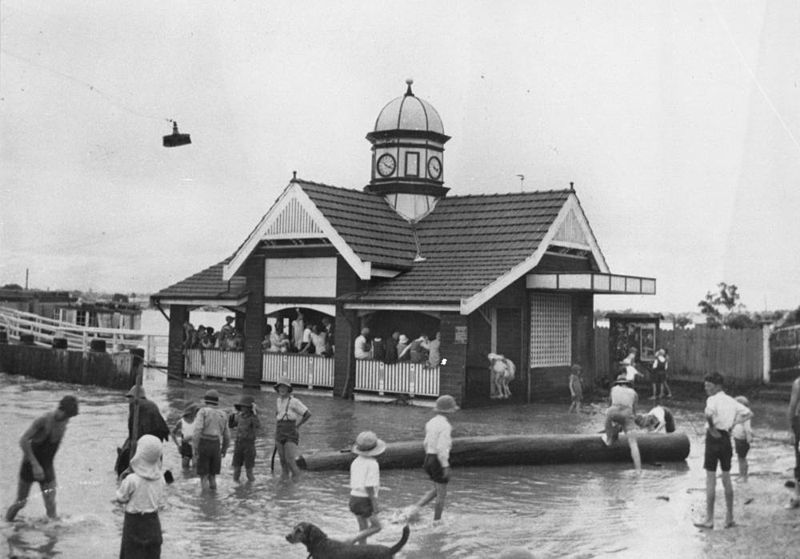
Oxford Street Ferry Terminal during the 1890 floods. No brewery and amazingly, there’s still no brewery in 2014.
Resolving the actual location of the brewery was the first step of a journey that has consumed the last few days. Due to my approach, this is less a history and more a series of anecdotes about Bulimba Brewery which may give you some insight into the city’s brewing past and the history of our municipality.
To find the appropriate context, you have to cast yourself back into late nineteenth century Brisbane. Founded in 1824 by people looking for a more horrible place to keep convicts than the rest of Australia could offer, Brisbane was a small colonial outpost and by the 1850s had become the de facto capital of the British colony of Queensland.
By 1882, when our story begins, speculation from Sydney had led to the first subdivisions of land on the river, Robert Porter was mayor (but only for the year) and about 40,000 people lived in the metropolitan area.
1882 to 1906
In June 1882, construction was underway for Robert Tooth’s new Eagle Brewery and Sugar Refinery. By December, the start of the Australian summer, production was underway with The Queenslander describing some interesting colour stratification in what I can only assume is one cask of the same beer:
There were about eight samples tried by the directors, who had with them a few friends…who are deemed good judges of a commercial article. The singularly clear and bright quality of the beer was the first matter for remark, and the colours of the various samples ranged from the palest straw colour to that which characterises the ordinary draught… Though the oldest sample was only brewed a fortnight ago it was pronounced of excellent quality, with that sound creamy head which is so much sought by connoisseurs… The light beer is exactly the thing required in a hot climate. It is more like the lager of Germany than anything else, but is more bitter… The whole of the liquor is different to any yet produced in the colonies, except it be the summer beer of Tasmania… A quantity of the beer sampled on Monday will be placed on the market at an early date.
Apparently, things didn’t go well for Tooth. In April, less than six months after the previous report was filed, the brewery, sugar refinery, land and buildings were up for sale, to be auctioned on May 8. I can’t find any explanation for this, although the reason seemed to be common knowledge. I wonder if he moved to Sydney? (EDIT: Turns out the Tooth’s in Sydney is different from the Brisbane one)
The lot sold to a Mr Huesman on behalf of a syndicate for £15,500 (or very approximately AU$2.5 million in today’s money). Production resumed in November, with the new Queensland Brewery Company having jettisoned the old brewing plant and brought in former Victorian Postmaster-General, state representative and brewer Henry Bolton to oversee production.
By December, it seemed it was business as usual. The Brisbane Courier reported:
We have to acknowledge receipt of a sample of ale from the new Bulimba brewery. Although somewhat sweet and new it has every characteristic of a beer likely to suit consumers in this climate. It is really light, partaking some-thing of the character of lager beer, and it is remarkably clear and pleasant looking. If the new brewery continues to produce ale of this quality it ought to do a very good business.
Bulimba Brewery was soon turning out both ale (unknown style) and porter. Bulimba beers appeared regularly at the Exhibition, the precursor to today’s Ekka, frequently medalling.
The Punch and Figaro toured the brewery in 1886, recounting much detail (with a generous helping of mirth):
Bulimba Brewery commands a fine reach of the Brisbane river, near the Bulimba Ferry, and only those who know the hideous waste the locality was a few years ago can estimate the vast property improvements that have taken place there…
Mounting then to the top storey, we introduce ourselves to the raw malt…the mash being boiled by steam…A trap-door is seen, down through which the malt is sent into a crushing mill in the storey beneath, from which it is raised afterwards by elevators to the grist-case. From thence it is conveyed to the mash-tubs, which are provided with false bottoms, where it is mixed with boiling water in the cataract mashing machine. I was informed that the latter is the only one of its kind in Brisbane.
The liquor is next sent into the copper work boilers, while the ”grains” find their way down a shoot to the ground floor, where they, are at once carted off as fodder for stock.
A beautiful refrigerator for cooling the brew is on the second floor, and displays the nicest of thermometrical adjustments. Here we see the beer in huge tuns, in the process of fermentation. There are four tuns-two of which hold 35 hogsheads and two 25 hogsheads. There are also four temperators. The process of fermentation takes from 18 to 26 hours…
The water storage department is here also. Enoggera is kept in full supply to the capacity of eight 1500 gallon tanks… Tasmanian, German, and English hops are used – a blend being considered the correct pitch of excellence. Colonial and Mauritius sugars – all white crystals – are used, mostly colonial; though, in the brewer’s opinion, Mauritius are the best in quality…
There were only 282 barrels, of fifty-four gallons each, in the cellar… The beer, for immediate and local consumption, is sometimes sent out within three days of brewing. For consumption further afield, where it is required to be kept for a long period, it is necessary to give it a much longer chance of maturing… he ought to be a judge, that the Bulimba beer is a beautiful counter or table beer, and that he doesn’t even count lager beer as its superior. It is light, sparkling, and thirst quenching. The brewer is Mr. T. B. West, a thorough expert, and formerly of Sydney and Melbourne. The brewery occupies some seven acres in all, and is complete in. all its appointments and trade necessaries; only a visit to it would properly impress anyone with the magnitude of’its business.
Production was around 45 hogshead per day – around 107hL by today’s measure.
In it’s fifth year, the brewery was doing a very good business. The Queensland Brewery Company held a capital raising, looking for £150,000 and guaranteeing three years of 10% returns on investment. QBC were looking to install a “malting house, of the pneumatic principle”. A new brewery was constructed in Tooth’s old sugar refinery near the Bulimba ferry, the opening of which was noted in the Brisbane Courier on November 12. Despite Henry Bolton’s retirement in January 1888, at the first ordinary general meeting of the now publicly traded Queensland Brewery Co, the directors paid the promised 10% dividend (interim), having made a handsome £6,385 profit in the preceding twelve months.
In 1888, Bulimba Brewery had gained some new agents in the more distant reaches of Queensland. The Northern Miner, reporting on this, only had excellent things to say:
The sale of Bulimba ale is now greater than that of any other brew, and so much sought after by beer drinkers that every hotel in the district must keep it on tap, or lose a considerable share of the trade
Apparently, the beer was very popular in the Northern Regions (see Charters Towers). By early 1889, output had grown to fifty to sixty hogshead per day (120 to 140 hL).
Although a drayman’s cottage caught fire in 1891, worse was yet to come. 1893 was a horrible year to be in Brisbane. In February, three cyclones hit Brisbane in quick succession causing massive flooding. Described as a wall of water and wiping away bridges, it was some of the most catastrophic in the city’s history. To make matters worse, there was a fourth flood event in June, although it was barely a footnote as the worst had already happened.
The floods practically destroyed the rival West End Brewery. Amazingly, the riverside Bulimba Brewery seemed little affected:
Although ‘one could jump into the river from the brewery’, its situation beside the Bulimba Reach at present-day Teneriffe was such that the premises were never flooded. Advertisements run soon after the devastating event assured customers that the brewery was ‘above flood mark’ and could continue to supply its ‘well known and favourite Bulimba Beer’.
The Bulimba Reach is relatively insulated against the brunt of the destruction wrought by floods but there was little chance the brewery was “above the flood mark”.
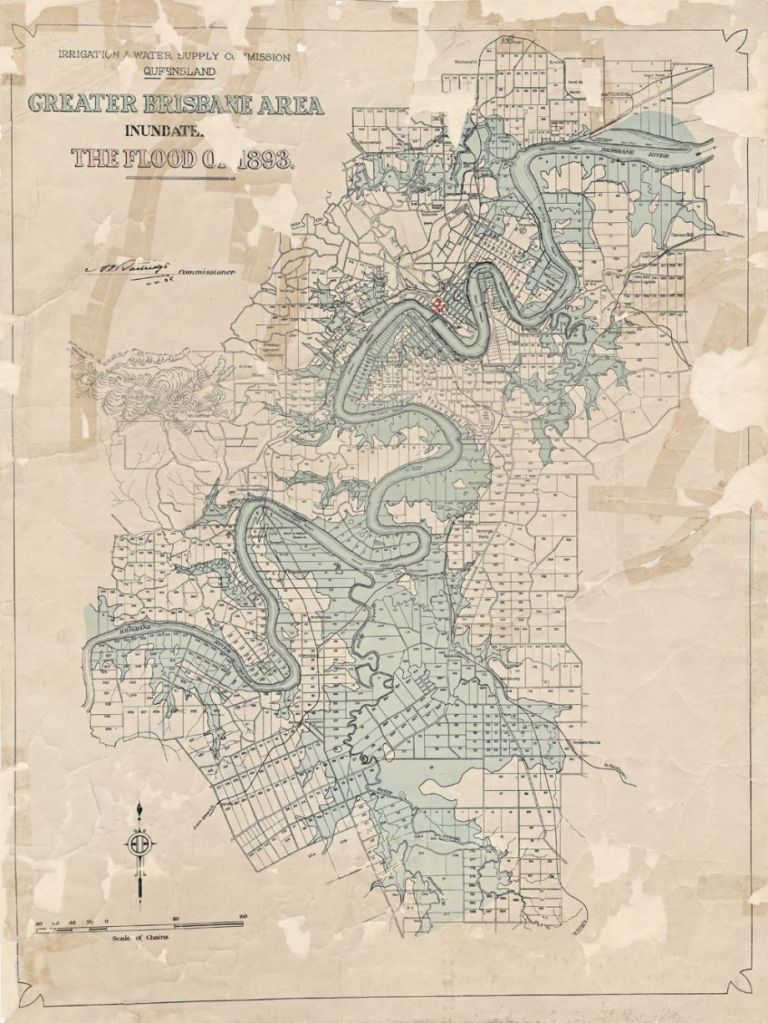
A map of the areas affected by the 1893 flood. I mark that the brewery was in the blue but not by much. Note the extensive invasion through the southern suburbs, far distant from the river itself as the waters rose in local creeks, compared to the minimal inundation experienced in the Brisbane-side of Bulimba.
As natural disasters seems to be one of the few occasions deemed worthy of breaking out the camera in the 1890s, the floods offered an opportunity to get a photo of the brewery. Unfortunately, I have no idea what the brewery looked like, although this offers some unsourced insight:
“This establishment, viewed from the river is perhaps the most picturesque brewery in the southern hemisphere. Its buildings are fairly embowered in foliage. On this strand also are the wharves of the Queensland and British India Navigation Companies, and the new furnaces of the Brisbane Gas Company are in the course of erection.”
My guess – and I’m happy to be corrected – is that it’s the big building with the chimney.
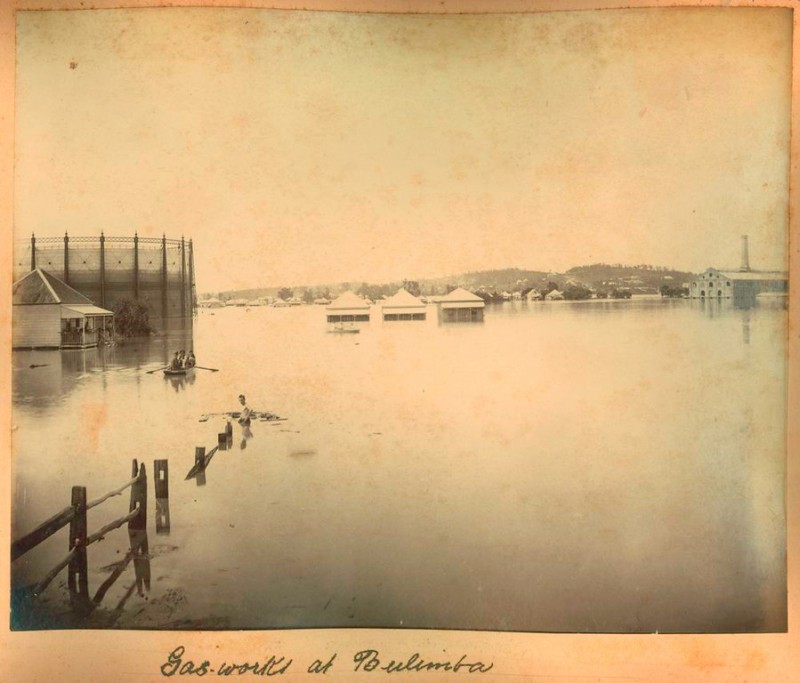
1893 Flood. The gas furnace is on the left and still stands today next to a shopping centre that bears its name. The building on the right might be the brewery.

A clearer view c.1898 from Hamilton Hill across Bulimba Reach and to Newstead. The smoke stack is about the right location but perhaps is too far downstream to be the brewery.
For such a famous* landmark, I find the fact that the mystery exists, itself mystifying. Hopefully someone can provide some insight.
*Most references in the newspapers to Bulimba Brewery are due to a dead body washing up near the brewery or for rowing regattas held on the stretch of the river in front of the brewery. I hope the two are not related.
Undeterred, the city continued to grow and Bulimba Brewery’s trade grew right along with it. By the ’99 Exhibition, Bulimba Gold Top – the brewery’s most famous marque – had been introduced:
…special notice must be given to their fine product known as “Gold Top” Bulimba beer, which is particularly adapted for the Queensland climate, and is fast superseding imported bottled ales, especially in the northern districts of the colony, where a light, wholesome, appetising, and moderately stimulating drink is so essential. This very superior beer, which might well have been named “Eureka Gold Top ” – for it is precisely the article which has long been a desideratum in the colonies, and which other breweries hate for years vainly endeavoured to supply – has received the highest recommendations from many of the medical profession, not a few of whom “practise what they preach”…
Bulimba Gold Top was a gamechanger. It was the brewery’s (debatable) first foray into making bitter. To prove a point, Bulimba Gold Top secured the patronage of the Governor of Queensland for the beer consisting of “sugar, English malt, New Zealand, Kent and Bohemian hops”.
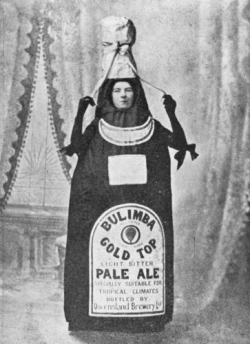
The daughter of the managing director of the Queensland Brewery Co dresses up for a party in 1900 as a bottle of Gold Top.
In 1901, Bulimba Brewery was producing at least three different beers, both bottled and draught: stout, light bitter (Gold Top) and mild (Silver Top). A XXX Sparkling Ale also seems to have been available and appears to have been bottle conditioned, rather than “aerated”. The beers compared favourably to English beers, presumably the highest compliment payable to a Brisbane brewery:
“Do you know,” said he, “the other day I drank a glass of your beer and thought it was British?”
“Now that’s funny,” replied the Bulimba man, “the other day I drank a glass of British beer and discovered the mistake at once.”
Demand for Bulimba beer spread interstate to the Northern Rivers of New South Wales in 1902. Considering that the nation had only federated a year earlier and that rivalries between the former colonies still existed, this must have been a serious feather in the cap of the brewery. QBC may have been taking advantage of the recently eliminated inter-colonial alcohol duties.
However, in 1906, the original Bulimba Brewery was shut down. I haven’t been able to find why it was closed but I suspect that the company simply outgrew its original premises and had to move. It certainly wasn’t for a lack of demand.
1906 to now
The brewery buildings were sold off in February 1906. Beer production was moved to a former tobacco factory and then Valley Brewery on Brunswick Street in Fortitude Valley. QBC was eventually bought out by Carlton & United Breweries, who shifted the state’s production to Yatala. CUB was bought by Fosters in 1983, which in turn was bought by SABMiller in 2011.

The Valley Brewery, owned and operated by Queensland Brewery Co, in 1906 (nicked from libraryhack.anotherbyte.net)

The “Bulimba” Brewery in 1938 at the end of the near complete Story Bridge (nicked from brisbanebeertours.com)
Bulimba-branded beers – specifically, Bulimba Gold Top and Bulimba Pilsner – continued on well into the 1970s into the 1980s before being discontinued by Carlton, presumably to make way for another dreary lager. Bulimba Gold Top, along with Brisbane Bitter, were revived briefly in 2011, so CUB could hold onto their trademark. Judging by the Dan Murphys reviews, it wasn’t anything to get excited about.
The site was sold to Dalgety and Company, the first pastoral group to move into the area to take advantage of the close of proximity of rail and river in Queensland’s largest population centre. From what I can gather, they demolished the original brewery building and re-built something more suited to their needs.
Through the 1910s and 20s, the suburb became a hub of shipping and sheep. After Dalgety & Co merged with a New Zealand firm in 1961, the site was sold in 1964 to Queensland Primary Producers, then again to 1984 to John Stephens who operated Paddy’s Markets.
By the 1990s, Teneriffe had fallen into disrepair, as woolsheds were no longer economically viable in the inner suburbs of Brisbane, and was earmarked for revival by the local council. The woolsheds were converted into apartments and have been home to wealthy inner city yuppies since the turn of the century.
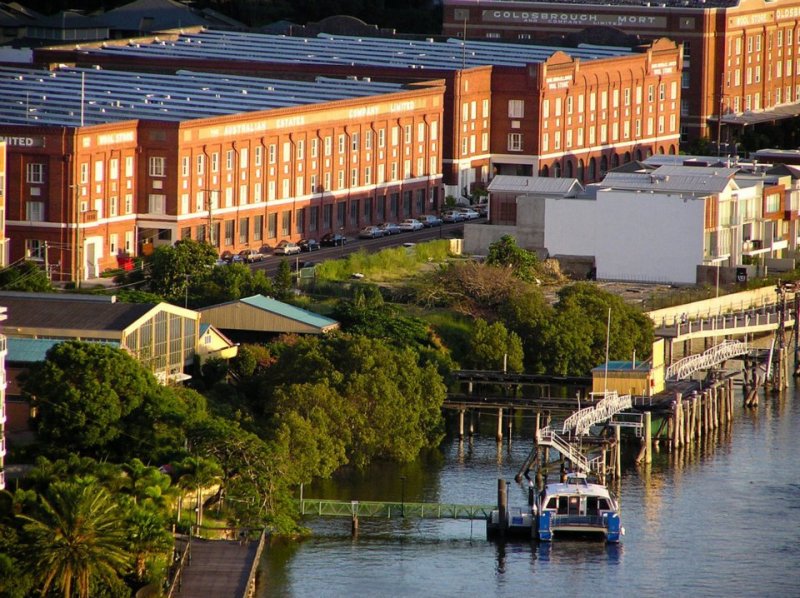
Vernon Terrace, Teneriffe today with the river in the foreground and the woolstores in the background (nicked from Lost Brisbane, Facebook)
Although the Bulimba trademarks are held by Victorians (and South Africans), brewing continues in the area today with Newstead Brewing Co and Green Beacon Brewery. I wonder if people will write about their breweries a century from now?








That was excellent and thoroughly enjoyable.
I don’t even want to think about how much work this article must have been.
Thanks Judd. It was the hurried work of four nights because this stuff is mostly spillover from another post I had planned. Still the longest post (and most thoroughly researched) we’ve ever written.
Really great work! Thanks for sharing it. It’s a shame that the story for so many good breweries from the 19th century ends (or at least begins to decline) with being bought out sometime soon after federation. Especially since it means the recipe details and log books remain out of our grasp.
Thanks Nick, although, for the record, CUB bought QBC in 1961.
Fair enough, I misread the post. It had the same unfortunate result though.
I have a feeling Gold Top wouldn’t be something we would enjoy today, irrespective of whether it was the 1899, 1961 or ’80s version. Sugar was the key ingredient, which makes it sound like a template for today’s industrial lagers.
On the other hand, CUB gave us this Gold Top ad:
Great article, thanks for sharing.
If you go into the old Balmoral hotel, now Oxford 152 there is a nice photo of the original Bulimba brewery on the back wall, I have an original Bulimba brewery beer crate in my workshop ay Bulimba Service Centre 07 33955905. Great article, thanks. Kev.
Pingback: Meet the Beer Media – Drunken Speculation | beer is your friend
In 1958 the British India Steam Navigation Company built a ship in Glasgow named MS Bulimba, and launched it with a bottle of Bulimba Beer, instead of the traditional champagne. The ship arrived in Brisbane during her maiden voyage, probably in late 1958, and was the subject of intense publicity at the time. To celebrate this event all of the ship’s company were given a bottle of Bulimba beer.( The old quart size bottles). TV cameras covered the arrival, an industry in it’s infancy at the time. The ship was berthed at the old Brett’s wharf. The shipping company BISN, had a long history of trading to and from India to Queensland, and there is a permanent monument to this association located in Newstead Park, put there in 1958.
I was a junior engineer serving on the ship at this time, and well recall the interest this visit aroused in Brisbane Further interest came about because we had on board, en route to Taronga Park zoo in Sydney, a rare Nepalese lion cub, which roamed around the Officers accommodation in complete freedom all the way from Calcutta to Sydney.
Wow, thanks for sharing that Colin. What a fascinating bit of history you’ve got up your sleeve. You may not be aware but in a year or two, this site will be archived again by the National Library and stuff like this is what being archived really important to me.
A very good article, thanks. Just one point re the location, in the first photo “Gas Works at Bulimba ” the building on the top right was the gas works retort house ( I used to work for Brisbane Gas Co in the late 1960’s when part of it was still visible) Its also centre in the next pic and tight in the third one. I now wish I had taken photos of the place when I worked there. It was a great place for a young engineer to start a career.
Great read … I actually have an old Bulimba Brewery Wooden crate .
Hi. a friend of mine brought a bulimba brewery wooden crate but there is some of the print is gone and he would like a photo of the side of the crate so if anybody has a photo to help him please email me on woodies46@gmail.com. This would help. Thank you Russell
The Lion Brewery in Townsville was also killed off by CUB around 1927, when they bought out the majority of the shares. Corner of Flinders and Knapp Sts. It was a very old style gravity fed system. The grain went in the at top 4th storey, and beer came out the ground floor. The vertical house was Eager’s Holden for many years, but is now a night club.
One poster insisted sugar was the key ingredient of BG. Maybe so. Sugar can be used in beer, as a minority ingredient, provided the ferment temp is at least a few degrees above 20C. The very bitter final taste then does not occur. Sugar gives a lighter and slightly dryer finish to the beer, but does need a bit longer to mature. All disaccharides, including molasses, have a very bitter taste (acetaldehyde) when fermented below 20C.